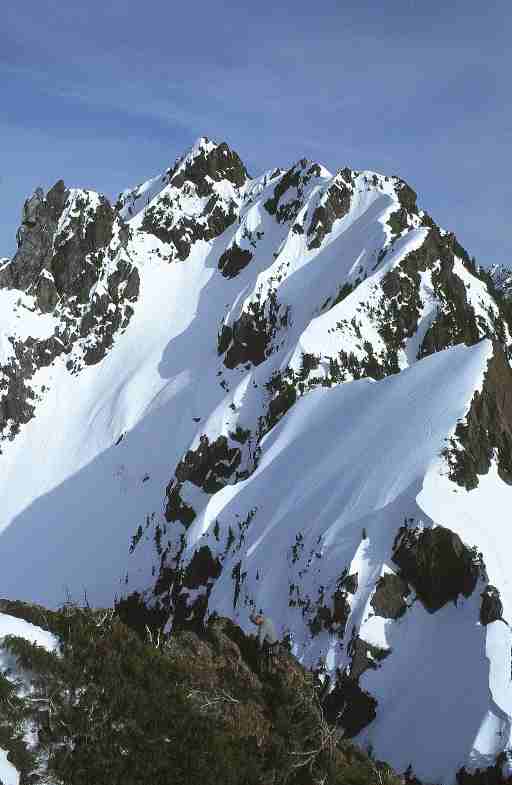 |
|
Cat's Ears Peak
CAT’S EARS - WEST RIDGE INTEGRÀLE
by Sandy Briggs
April 9-11, 2004
The party: Sandy Briggs, Julie Deslippe, Paul Rydeen, Hinrich Schaefer, Darren Wilman.
After our return from Cat’s Ears I commented to Hinrich that, were
it not for the seven-hour bushwhacking approach, the complete (integrÀle)
west ridge would be an Island classic. He replied that perhaps it is an
Island classic because of the seven-hour bushwhack.
I had wanted to try this route ever since I first looked along it in April
1997. But that trip was turned back by deep snow and a shortage of time,
so we gave ourselves to watching such things as comet Hale-Bopp and the
peculiar New Zealand sport of cornice jumping.
It took me a few years to get another attempt together, but when it happened
it was with a perfect crew (well, except for one or two notable absences),
and we had perfect weather again.
A short way up the Cat’s Ears creek road we plunged into the second
growth, such as it is. I chose a devious line through the worst of the
alder, nettles, devil’s club and cross-piled logs – a route
notable for the long intervals during which my feet were quite invisible.
Paul and Darren, canny lads that they are, rejected this route immediately
and fared rather better only 50 m to the right, amongst actual trees.
By the time Hinrich and Julie and I had caught up to them I had sufficiently
regained my presence of mind to claim that by my having selected a particularly
engaging bit of greenery at the outset, any bushwhacking likely to arise
later would appear mellow by comparison and would therefore not generate
any negative commentary, which is, naturally, much harder to bear when
one is tired.
Once the ridge proper was gained, and with it the old-growth forest, the
course was southwest and upward, by-passing various bluffs on the left,
until we reached the open bump at 3801ft (1155m), where we camped. While
Cat’s Ears itself is deceptively unprepossessing from this angle
it cannot be said that one’s eye is starved for stimulation, with
the jagged Mackenzie Range jutting skyward to the south, while the Maitland
Range teams up with it to frame Kennedy Lake, Long Beach, and the great
Pacific Ocean.
The following morning was fine and warm – actually a bit too warm
for an Easter weekend. (No wonder the glaciers are all disappearing so
quickly.) We romped along the initial broad and undulating parts of the
ridge, eventually caching our snowshoes at the base of the first real
steepness, where we also donned crampons. For much of the remainder of
the route we moved in roped teams, or at least had the rope at the ready,
belaying the occasional exposed parts here or there and paying attention
to the possibility of an avalanche. The snow was in great condition, firm
enough for us to profit from the crampons yet soft enough for secure ice-axe
belays. This year, all the major cornices had already dropped off by Easter.
From the first high summit we did a short rappel over a rock step. After
that a narrow arÊte led to a short bushy gully that led down easily
and dropped one near a left-sloping triangular face. After that the route
was a wonderful snowy catwalk in the sky, characterized by impressive
exposure and little difficulty.What a delight! Just before the final summit
we had to avoid a rock step by descending to the right and traversing
on steep terrain to a broad gully that led almost to the base of the summit
pitch. This final rock climb was low fifth-class and posed no problems,
so that we soon found ourselves on the top, where we lingered for the
usual rituals.
I feel I need to emphasize that the twists and turns, the ups and downs
of this very indirect route are outrageously fun – so much so that
I will venture to comment that he (or she) who has climbed Cat’s
Ears from the north, gaining the ridge only near the summit, has cheated
himself (or herself) of significant pleasure. I think I can also reasonably
assert that the scenery to which your aesthetic sensibilities are subjected
at every moment for hour upon hour is to be matched in only a few other
Island locales, among which must be counted Rugged Mountain, Limestone
Cap, and the peaks along the east side of the Elk River valley.
We rappelled the rock pitch and enjoyed the luxury of romping back along
the route in the opposite direction. The rock step to the west summit
was easily climbed, and there we took a long rest in the late afternoon
sun, lest the day’s magic come to an end too soon.
Sandy Briggs
